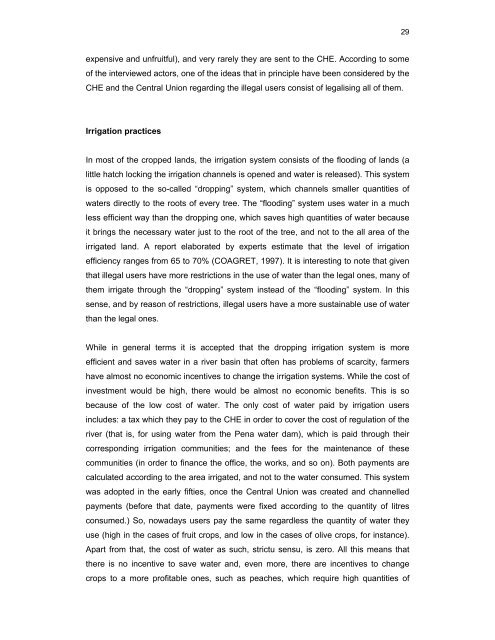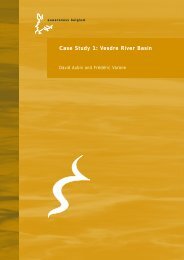Case Study 1: Matarraña River Basin - Euwareness
Case Study 1: Matarraña River Basin - Euwareness
Case Study 1: Matarraña River Basin - Euwareness
Create successful ePaper yourself
Turn your PDF publications into a flip-book with our unique Google optimized e-Paper software.
expensive and unfruitful), and very rarely they are sent to the CHE. According to some<br />
of the interviewed actors, one of the ideas that in principle have been considered by the<br />
CHE and the Central Union regarding the illegal users consist of legalising all of them.<br />
Irrigation practices<br />
In most of the cropped lands, the irrigation system consists of the flooding of lands (a<br />
little hatch locking the irrigation channels is opened and water is released). This system<br />
is opposed to the so-called “dropping” system, which channels smaller quantities of<br />
waters directly to the roots of every tree. The “flooding” system uses water in a much<br />
less efficient way than the dropping one, which saves high quantities of water because<br />
it brings the necessary water just to the root of the tree, and not to the all area of the<br />
irrigated land. A report elaborated by experts estimate that the level of irrigation<br />
efficiency ranges from 65 to 70% (COAGRET, 1997). It is interesting to note that given<br />
that illegal users have more restrictions in the use of water than the legal ones, many of<br />
them irrigate through the “dropping” system instead of the “flooding” system. In this<br />
sense, and by reason of restrictions, illegal users have a more sustainable use of water<br />
than the legal ones.<br />
While in general terms it is accepted that the dropping irrigation system is more<br />
efficient and saves water in a river basin that often has problems of scarcity, farmers<br />
have almost no economic incentives to change the irrigation systems. While the cost of<br />
investment would be high, there would be almost no economic benefits. This is so<br />
because of the low cost of water. The only cost of water paid by irrigation users<br />
includes: a tax which they pay to the CHE in order to cover the cost of regulation of the<br />
river (that is, for using water from the Pena water dam), which is paid through their<br />
corresponding irrigation communities; and the fees for the maintenance of these<br />
communities (in order to finance the office, the works, and so on). Both payments are<br />
calculated according to the area irrigated, and not to the water consumed. This system<br />
was adopted in the early fifties, once the Central Union was created and channelled<br />
payments (before that date, payments were fixed according to the quantity of litres<br />
consumed.) So, nowadays users pay the same regardless the quantity of water they<br />
use (high in the cases of fruit crops, and low in the cases of olive crops, for instance).<br />
Apart from that, the cost of water as such, strictu sensu, is zero. All this means that<br />
there is no incentive to save water and, even more, there are incentives to change<br />
crops to a more profitable ones, such as peaches, which require high quantities of<br />
29



